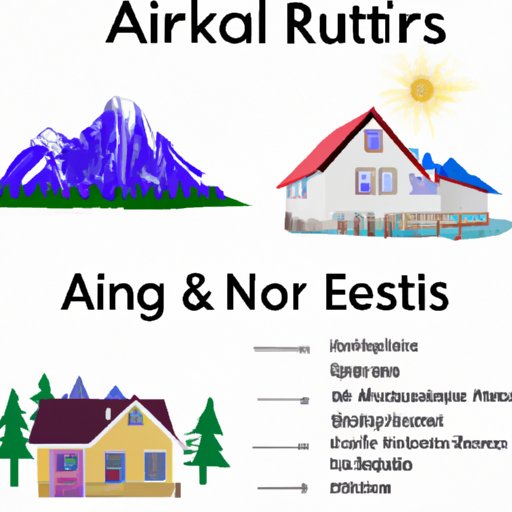Introduction
The cost of living in Alaska is an important factor to consider when deciding on whether or not to relocate to the great state. From housing costs to food expenses, it’s essential to understand all of the associated costs before making a decision. In this article, we’ll explore the cost of living in Alaska, including factors that affect the cost, renting vs buying, average monthly expenses, and tax rates & financial benefits.

Renting vs Buying in Alaska
When considering the cost of living in Alaska, it’s important to weigh the pros and cons of renting vs buying. According to Zillow, the median home value in Alaska is $319,900, which is significantly higher than the national median home value of $228,200. Additionally, the median rent price in Alaska is $1,717 per month, which is higher than the national median of $1,474.
When weighing the pros and cons of renting vs buying, there are several factors to consider. The biggest pro for renting is that it allows for more flexibility and mobility, as renters can move without having to worry about selling their home. On the other hand, purchasing a home can be a great investment opportunity, as homeowners can build equity over time and benefit from potential appreciation of their home’s value. Ultimately, the decision should depend on individual needs and preferences.
Average Monthly Expenses in Alaska
In addition to the cost of renting or buying, there are several other monthly expenses to consider when calculating the cost of living in Alaska. According to an analysis conducted by Business Insider, the average monthly expenses for a single person living in Alaska are approximately $3,873. This includes housing expenses, food and dining out, transportation, utilities and other home services, and taxes.
Housing Expenses in Alaska
Housing expenses are one of the most significant costs of living in Alaska. According to the U.S. Census Bureau, the median monthly housing cost for owner-occupied households in Alaska is $1,380. For renters, the median monthly housing cost is $1,072.
Food and Dining Out Expenses in Alaska
Food and dining out expenses make up a significant portion of the cost of living in Alaska. According to Numbeo, the average cost of a meal for two people at a mid-range restaurant in Alaska is $50. Additionally, the average cost of a grocery shopping trip for two people is approximately $120.
Transportation Expenses in Alaska
Transportation expenses can also add up quickly. According to GasBuddy, the average cost of gas in Alaska is $3.02 per gallon. Additionally, the average cost of public transportation in Alaska is $2.00 per ride.
Utilities and Other Home Services in Alaska
Utilities and other home services can also add up quickly. According to the U.S. Energy Information Administration, the average monthly electricity bill in Alaska is $114. Additionally, the average cost of internet service in Alaska is $60 per month.
Tax Rates & Financial Benefits in Alaska
In addition to the cost of living in Alaska, it’s also important to consider the associated tax rates and financial benefits. According to the Tax Foundation, Alaska has no state income tax, but does have a 6.5% sales tax. Additionally, Alaska offers several financial benefits, such as the Permanent Fund Dividend, which provides eligible Alaskans with an annual dividend derived from investments made with oil revenues.
Conclusion
As you can see, the cost of living in Alaska is an important factor to consider when deciding on whether or not to relocate to the great state. From housing costs to food expenses, it’s essential to understand all of the associated costs before making a decision. When weighing the pros and cons of renting vs buying, there are several factors to consider, including flexibility and mobility. Additionally, there are several other monthly expenses to consider, such as housing, food and dining out, transportation, utilities and other home services, and taxes. Finally, it’s important to consider the associated tax rates and financial benefits available in Alaska.
Overall, the cost of living in Alaska can vary significantly depending on individual needs and preferences. However, by understanding the associated costs and benefits, individuals can make an informed decision when deciding whether or not to relocate to Alaska.
(Note: Is this article not meeting your expectations? Do you have knowledge or insights to share? Unlock new opportunities and expand your reach by joining our authors team. Click Registration to join us and share your expertise with our readers.)
